Cupro offers a silky texture and breathability ideal for luxurious skirts, while Tencel provides superior moisture-wicking and eco-friendly benefits suitable for sustainable fashion. Both materials deliver softness, but Cupro excels in drape and sheen, whereas Tencel emphasizes durability and environmental impact.
Table of Comparison
| Feature | Cupro | Tencel |
|---|---|---|
| Material Type | Regenerated cellulose fiber from cotton linter | Lyocell fiber from sustainably sourced eucalyptus wood |
| Texture | Silky, smooth, breathable | Soft, smooth, breathable |
| Moisture Management | Excellent moisture absorption | High moisture-wicking ability |
| Environmental Impact | Moderate; uses chemicals but biodegradable | Low; eco-friendly closed-loop process |
| Durability | Moderate; prone to delicate handling | High; strong and resistant to wear |
| Care Instructions | Hand wash or dry clean recommended | Machine washable, gentle cycle preferred |
| Ideal Use in Skirts | Luxury feel, drapes elegantly | Comfortable, breathable, easy care |
Introduction to Cupro and Tencel
Cupro is a regenerated cellulose fiber made from cotton linter, known for its smooth texture and breathable qualities, making it ideal for skirts that require a luxurious drape. Tencel, a brand of lyocell fiber derived from sustainably sourced wood pulp, offers excellent moisture-wicking properties, durability, and eco-friendliness. Both materials provide comfort and elegance, but Cupro stands out for its silk-like finish, while Tencel emphasizes sustainability and strength.
What is Cupro?
Cupro is a regenerated cellulose fiber made from cotton linter, offering a silky texture and breathable quality ideal for skirts. Its smooth, moisture-wicking properties make Cupro skirts comfortable and lightweight, perfect for warm weather. Compared to Tencel, Cupro provides a more luxurious sheen and a silk-like drape, enhancing the elegance of skirt designs.
What is Tencel?
Tencel is a sustainable fabric made from eucalyptus wood pulp, prized for its softness, breathability, and moisture-wicking properties, making it ideal for skirts. It offers excellent drape and durability, providing comfort in various climates while being eco-friendly due to its closed-loop production process that recycles water and solvents. Compared to cupro, Tencel is more environmentally friendly and resistant to wrinkles, making it a preferred choice for lightweight, breathable skirts.
Sustainability and Eco-Friendliness
Cupro, a regenerated cellulose fiber derived from cotton linter waste, offers biodegradability and minimal chemical use, making it a sustainable choice for skirts. Tencel, produced from sustainably sourced eucalyptus wood using a closed-loop process that recycles water and solvents, provides outstanding eco-friendliness and reduced environmental impact. Both fibers excel in sustainability, but Tencel's superior resource efficiency and certifications like OEKO-TEX and FSC enhance its eco-conscious appeal for skirt fabric.
Feel and Texture Comparison
Cupro offers a silky, smooth texture with a soft drape that mimics high-quality silk, providing a cool and breathable feel ideal for skirts. Tencel, made from eucalyptus fibers, has a slightly more matte finish and a gentle, luxurious softness that enhances moisture-wicking properties, making it comfortable for extended wear. Both fabrics are sustainable choices, but Cupro tends to feel more fluid and lustrous, while Tencel feels more structured yet supple.
Breathability and Comfort
Cupro fabric offers excellent breathability due to its natural cellulose fibers, making it ideal for skirts that require moisture-wicking properties and a smooth, silk-like feel. Tencel, derived from sustainably sourced eucalyptus trees, provides superior comfort with its soft texture and enhanced moisture management, preventing overheating during extended wear. Both materials excel in breathability and comfort, but Tencel's eco-friendly production and durability often make it the preferred choice for high-performance skirts.
Durability and Maintenance
Cupro fabric offers moderate durability with a soft, silk-like texture but requires delicate care such as hand washing or dry cleaning to maintain its appearance in skirts. Tencel is recognized for its exceptional strength and resilience, making skirts more durable and easier to maintain with machine washable properties and resistance to wrinkles and shrinkage. For long-lasting skirts, Tencel provides superior durability and low-maintenance care compared to the more fragile Cupro.
Draping and Aesthetic Appeal
Cupro offers a smooth, silky drape with a subtle sheen that enhances the fluidity and elegance of skirts, making them ideal for formal and sophisticated looks. Tencel boasts excellent draping qualities due to its softness and breathability, creating a natural, flowy silhouette that complements casual and eco-conscious fashion. Both fabrics provide impressive aesthetic appeal, with Cupro delivering a luxurious finish and Tencel emphasizing organic texture and comfort.
Price and Affordability
Cupro fabrics generally offer a more affordable price point compared to Tencel, making them an attractive choice for budget-conscious shoppers seeking luxury feel in skirts. Tencel, derived from sustainably sourced wood pulp, tends to be priced higher due to its eco-friendly production process and superior moisture-wicking properties. Consumers looking for cost-effective skirts with breathability and softness often prefer Cupro, while those prioritizing sustainability and durability may opt for the higher-priced Tencel options.
Which is Better for Skirts: Cupro or Tencel?
Tencel offers superior breathability and moisture-wicking properties, making it ideal for comfortable, everyday skirts, especially in warm climates. Cupro provides a luxurious silk-like finish with excellent drape and is highly breathable, but it requires more delicate care. For skirts, Tencel is better suited for durability and eco-friendliness, while Cupro excels in softness and elegance.

Infographic: Cupro vs Tencel for Skirt
 azmater.com
azmater.com